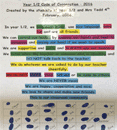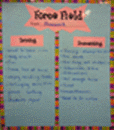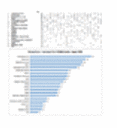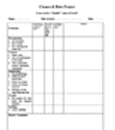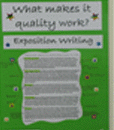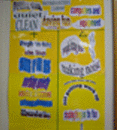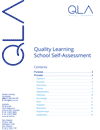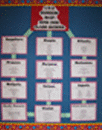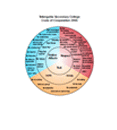Examples
Bone Diagram: Year 10 Work Ethic and Quality Work
A Bone Diagram is a system reflection and planning tool. It help clarify the current state the desired future state along with the forces that are driving and restraining progress towards the desired state. This example from Richard Maynards year 10 class at Seaford 6-12 School SA.
Capacity Matrix: Agriculture Vegetables (Year 9)
A Capacity Matrix is a tool to describe document and monitor learning. An example of a Capacity Matrix for Year 9 Agriculture prepared by Leanne Sjollema from McCarthy Catholic College Tamworth NSW.
Capacity Matrix: Algebra (Year 8)
A Capacity Matrix is a tool to describe document and monitor learning. An example of a Capacity Matrix for Year 8 Paterns and Algebra - developed by Yvette Riley and colleagues at Woodville High School in South Australia.
Capacity Matrix: Australian Professional Teaching Standards
A Capacity Matrix based upon the Australian Institute for Teaching and School Leadership (AITSL) Professional Teacher Standards.
Capacity Matrix: Description (Stage 3)
A Capacity Matrix is a tool to describe document and monitor learning. An example of a Capacity Matrix based on the NSW curriculum for Stage 3. Developed by a team of Armidale Diocesan teachers.
Capacity Matrix: Digital Images with a Camera
A Capacity Matrix is a tool to describe document and monitor learning. An example of a Capacity Matrix for taking images with a digital camera - provided by Robyn Roberts in Victoria.
Capacity Matrix: Digital Images with a Scanner
A Capacity Matrix is a tool to describe document and monitor learning. An example of a Capacity Matrix for scanning and using digital images for learning - provided by Robyn Roberts in Victoria.
Capacity Matrix: Discussion (Stage 3)
A Capacity Matrix is a tool to describe document and monitor learning. An example of a Capacity Matrix based on the NSW curriculum for Stage 3. Developed by a team of Armidale Diocesan teachers.
Capacity Matrix: Drama (Year 10)
A Capacity Matrix is a tool to describe document and monitor learning. An example of a Capacity Matrix for Year 10 Drama - developed by Michael Winter at Seaford 6 - 12 School in South Australia.
Capacity Matrix: Earth and Space (Year 7 and 8)
A Capacity Matrix is a tool to describe document and monitor learning. An example of a Capacity Matrix for the Earth & Space - developed by Danielle Poole at Seaford 6 - 12 School in South Australia.
Capacity Matrix: English (Year 8 to 10)
A Capacity Matrix is a tool to describe document and monitor learning. An example for Year 8 to 10 English developed by Helen Portellos at Woodville High School in South Australia.
Capacity Matrix: ESL Discussion Essay (Year 11)
A Capacity Matrix is a tool to describe document and monitor learning. An example developed by Stella Emberson of Woodville High School in South Australia: discussion essay for English as a Second Language students.
Capacity Matrix: Excel Column Chart (1 of 2)
A Capacity Matrix is a tool to describe document and monitor learning. An example of a Capacity Matrix for creating a column chart in Excel (part 1) - provided by Robyn Roberts in Victoria.
Capacity Matrix: Excel Column Chart (2 of 2)
A Capacity Matrix is a tool to describe document and monitor learning. An example of a Capacity Matrix for creating a column chart in Excel (part 2) - provided by Robyn Roberts in Victoria.
Capacity Matrix: Explanation (Stage 3)
A Capacity Matrix is a tool to describe document and monitor learning. An example of a Capacity Matrix based on the NSW curriculum for Stage 3. Developed by a team of Armidale Diocesan teachers.
Capacity Matrix: Exposition (Stage 3)
A Capacity Matrix is a tool to describe document and monitor learning. An example of a Capacity Matrix based on the NSW curriculum for Stage 3. Developed by a team of Armidale Diocesan teachers.
Capacity Matrix: High School Drama
A Capacity Matrix is a tool to describe document and monitor learning. An example of a Capacity Matrix for drama - provided by Seaford 6-12 School South Australia.
Capacity Matrix: High School Science
A Capacity Matrix is a tool to describe document and monitor learning. An example of a Capacity Matrix for science - provided by Seaford 6-12 School South Australia.
Capacity Matrix: Information Report (Stage 3)
A Capacity Matrix is a tool to describe document and monitor learning. An example of a Capacity Matrix based on the NSW curriculum for Stage 3. Developed by a team of Armidale Diocesan teachers.
Capacity Matrix: Kindergarten Literacy Recount
A Capacity Matrix is a tool to describe document and monitor learning. An example of provided Donna Gold of Dareton Public School NSW.
Capacity Matrix: Kindergarten Numeracy Multiplication
A Capacity Matrix is a tool to describe document and monitor learning. An example of provided Donna Gold of Dareton Public School NSW.
Capacity Matrix: Kindergarten Numeracy Whole Number
A Capacity Matrix is a tool to describe document and monitor learning. An example of provided Donna Gold of Dareton Public School NSW.
Capacity Matrix: Kindergarten Reading
A Capacity Matrix is a tool to describe document and monitor learning. An example of a Capacity Matrix based on the NSW curriculum for Early Stage 1. Developed by a team of Armidale Diocesan teachers.
Capacity Matrix: Listening (Year 5 and 6)
A Capacity Matrix is a tool to describe document and monitor learning. An example of a Capacity Matrix for Year 5 & 6 listening - provided by Robyn Roberts from Coburg North Primary School Victoria.
Capacity Matrix: Measurement (Stage 5)
A Capacity Matrix is a tool to describe document and monitor learning. An example of a Capacity Matrix for NSW Stage 5 Mathematics parts of the Measurement Strand. Developed by QLA.
Capacity Matrix: Measurement (Year 8)
A Capacity Matrix is a tool to describe document and monitor learning. An example of a Capacity Matrix for Year 8 Measurement - developed by Yvette Riley and colleagues at Woodville High School in South Australia.
Capacity Matrix: Measurement and Geometric Reasoning (Year 9)
A Capacity Matrix is a tool to describe document and monitor learning. An example of a Capacity Matrix for the Measurement Spatial sence and Geometric Reasoning - developed by Richard Maynard at Seaford 6 - 12 School in South Australia.
Capacity Matrix: Music (Year 12)
A Capacity Matrix is a tool to describe document and monitor learning. An example of a Capacity Matrix for Year 12 Music Revision - developed by Michael Winter at Seaford 6 - 12 School in South Australia.
Capacity Matrix: Music (Year 7 and 8)
A Capacity Matrix is a tool to describe document and monitor learning. An example of a Capacity Matrix for Year 7/8 Music - developed by Michael Winter at Seaford 6 - 12 School in South Australia.
Capacity Matrix: Narative (Stage 3)
A Capacity Matrix is a tool to describe document and monitor learning. An example of a Capacity Matrix based on the NSW curriculum for Stage 3. Developed by a team of Armidale Diocesan teachers.
Capacity Matrix: NSW Professional Teaching Standards
A Capacity Matrix example used to describe document and monitor learning using the New South Wales Professional Teacher Standards.
Capacity Matrix: Number (Year 8)
A Capacity Matrix is a tool to describe document and monitor learning. An example of a Capacity Matrix for Year 8 Number - developed by Yvette Riley and colleagues at Woodville High School in South Australia.
Capacity Matrix: Number and Place Value (Year 5)
A Capacity Matrix is a tool to describe document and monitor learning. An example of a Capacity Matrix for Year 5 Number and Place Value prepared by Tim Holness from Namadgi School ACT.
Capacity Matrix: Pen License
A Capacity Matrix is a tool to describe document and monitor learning. An example of a Capacity Matrix for a Pen License - provided by Robyn Roberts from Coburg North Primary School Victoria.
Capacity Matrix: Plant Production (Year 12)
A Capacity Matrix is a tool to describe document and monitor learning. An example of a Capacity Matrix for Year 12 Plant Production prepared by Leanne Sjollema from McCarthy Catholic College Tamworth NSW.
Capacity Matrix: Poetry (Stage 3)
A Capacity Matrix is a tool to describe document and monitor learning. An example of a Capacity Matrix based on the NSW curriculum for Stage 3. Developed by a team of Armidale Diocesan teachers.
Capacity Matrix: Procedure (Stage 3)
A Capacity Matrix is a tool to describe document and monitor learning. An example of a Capacity Matrix based on the NSW curriculum for Stage 3. Developed by a team of Armidale Diocesan teachers.
Capacity Matrix: Quality Learner
A Capacity Matrix is a tool to describe document and monitor learning. An example of a Capacity Matrix for a Quality Learner - provided by Robyn Roberts from Coburg North Primary School Victoria
Capacity Matrix: Quality Learning
This booklet of Capacity Matrices, by QLA, details the concepts, practices and tools of Quality Learning.
Capacity Matrix: Quality Teaching Model
A Capacity Matrix example used to describe document and monitor learning using the NSW Quality Teaching Model.
Capacity Matrix: Reading Strategies (Year 5)
A Capacity Matrix is a tool to describe document and monitor learning. An example of a Capacity Matrix for Year 5 Reading Strategies prepared by Tim Holness from Namadgi School ACT.
Capacity Matrix: Recount (Stage 3)
A Capacity Matrix is a tool to describe document and monitor learning. An example of a Capacity Matrix based on the NSW curriculum for Stage 3. Developed by a team of Armidale Diocesan teachers.
Capacity Matrix: Response (Stage 3)
A Capacity Matrix is a tool to describe document and monitor learning. An example of a Capacity Matrix based on the NSW curriculum for Stage 3. Developed by a team of Armidale Diocesan teachers.
Capacity Matrix: Science (Year 12)
A Capacity Matrix is a tool to describe document and monitor learning. An example of a Capacity Matrix for HSC Science Skills prepared by Regina Menz from OConnor Catholic College Armidale NSW.
Capacity Matrix: Science Nervous System (Year 9)
A Capacity Matrix is a tool to describe document and monitor learning. An example of a Capacity Matrix for the Nervous System - developed by Danielle Poole at Seaford 6 - 12 School in South Australia.
Capacity Matrix: Speaking (Year 5 and 6)
A Capacity Matrix is a tool to describe document and monitor learning. An example of a Capacity Matrix for Year 5 & 6 speaking - provided by Robyn Roberts from Coburg North Primary School Victoria.
Capacity Matrix: Spelling
A Capacity Matrix is a tool to describe document and monitor learning. An example of a Capacity Matrix for Spelling based on the NSW curriculum from Early Stage 1 to Stage 3. Developed by a team of Armidale Diocesan teachers.
Capacity Matrix: Statistics (Year 9)
A Capacity Matrix is a tool to describe document and monitor learning. An example of a Capacity Matrix for Year 9 Statistics - developed by Yvette Riley and colleagues at Woodville High School in South Australia.
Capacity Matrix: Talking and Listening
A Capacity Matrix is a tool to describe document and monitor learning. An example of a Capacity Matrix based on the NSW curriculum from Early Stage 1 to Stage 3. Developed by a team of Armidale Diocesan teachers.
Capacity Matrix: Topic Talk
A Capacity Matrix is a tool to describe document and monitor learning. An example of a Capacity Matrix for speaking - provided by Robyn Roberts from Coburg North Primary School Victoria.
Capacity Matrix: Victorian Professional Teaching Standards
A Capacity Matrix example used to describe document and monitor learning using the Victorian Institute of Teachers professional standards.
Capacity Matrix: Year 3 Information Text
A Capacity Matrix is a tool to describe document and monitor learning. An example of a Capacity Matrix for Year 3 literacy - writing an information text provided by Roxburgh Homestead Primary School Victoria
Capacity Matrix: Year 3 Letter Writing
A Capacity Matrix is a tool to describe document and monitor learning. An example of a Capacity Matrix for Year 3 letter writing provided by Roxburgh Homestead Primary School Victoria.
Capacity Matrix: Year 3 Weather and Erosion
A Capacity Matrix is a tool to describe document and monitor learning. An example of a Capacity Matrix for Year 3 weathering and erosion - provided by Roxburgh Homestead Primary School Victoria
Capacity Matrix: Year 6 Leadership Behaviours
A Capacity Matrix is a tool to describe document and monitor learning. An example of a Capacity Matrix developed with year 6 students by Robyn Strangward at Theodore Primary School in Canberra ACT.
Code of Cooperation: Year 1/2
An example of a Code of Cooperation developed by Stephanie Tedd with her year 1/2 class.
Code of Cooperation: Year 10 Classroom
The Code of Cooperation is a list of statements created by a team to highlight the factors necessary for a high degree of cooperation. This example is from Richard Maynards year 10 class at Seaford 6-12 School SA.
Code of Cooperation: Year 6 Classroom
The Code of Cooperation is a list of statements created by a team to highlight the factors necessary for a high degree of cooperation. This example is from Theodore Primary School ACT.
Correlation Chart (Year 2)
Example of a Year 2 Learning Correlation Chart where students provide feedback on their learning and enjoyment of different learning areas.
Fishbone Diagram: Variation in Student Achievement
The Fishbone Diagram or Cause and Effect Diagram can be used to identify and document the possible causes of a given effect. This example prepared by QLA documents many of the causes of variation in student achievement.
Five Whys: LOTE (Indonesian)
The Five Whys tool helps us uncover the root causes of problems or it can aid our understanding of our own motivation. This example is from Plenty Parklands Primary School Victoria.
Five Whys? Year 8 Mathematics
The Five Whys tool helps us uncover the root causes of problems or it can aid our understanding of our own motivation. This example from Diana Cheynes maths class at Macleod College in Melbourne Victoria.
Flowchart (Deployment): Year 9 Planning
A Deployment Flowchart provides a pictorial representation of the steps in a process along with the people involved at each step. This example from Richard Maynards year 9 class at Seaford 6-12 School SA.
Flowchart: Assessment (High School)
A Flowchart provides a pictorial representation of the sequence of steps in a process. This example of the assessment process shown pictorially is from Hallett Cove School South Australia.
Flowchart: Guided Reading
A Flowchart provides a pictorial representation of the sequence of steps in a process. This example of the Guided Reading Process is from Amy Greens Year 1/2 class at Calewell Primary School ACT.
Flowchart: Morning Process (Year 1)
A Flowchart provides a pictorial representation of the sequence of steps in a process. This example of a Year 1 morning process shown pictorially is from Plenty Parklands Primary School Victoria.
Forcefield Analysis: Homework
Force Field analysis encourages identification of the systemic forces that drive and restrain improvement. This example comes from Plenty Parklands Primary School.
Forcefield Analysis: Mathematics (Year 9)
Force Field analysis encourages identification of the systemic forces that drive and restrain improvement. This example was prepared by Michael King at a NSW high school.
Mission Statement: Year 3 Classroom
An example of a Classroom Mission or Purpose statement.
PDSA Storyboard: Information Text (Year 6) (1 of 2)
An example Plan-Do-Study-Act (PDSA) storyboard of an improvement project to improve Year 6 information text writing.
PDSA Storyboard: Information Text (Year 6) (2 of 2)
An example Plan-Do-Study-Act (PDSA) storyboard of an improvement project to improve Year 6 information text writing.
Plan-Do-Study-Act (PDSA) Storyboard: Year 1 Reading
The Plan - Do - Study - Act cycle for improvement can be used to facilitate structured improvement in any areas of endeavour. A storyboard of an improvement project by Trevor Robinson at Roxburgh Homestead Primary School Victoria.
Process Accountability Matrix: Namadgi School
A Process Accountability Matrix makes clear who owns key processes who is responsible for enacting them and who needs to be kept informed along the way. This example is from Namadgi School in the ACT.
Quality (Success) Criteria: 5 Star Quality Work (Kindergarten)
Quality criteria are used by students and teachers to document a vision of excellence and ensure that submitted evidence of learning is of high quality. This example of quality criteria for 5 Star Quality Work in Kindergarten comes from Plenty Parklands Primary School Victoria.
Quality (Success) Criteria: A Stimulating Classroom (Early Years)
Quality criteria are used by students and teachers to create a vision of excellence. This example of quality criteria for a stimulating classroom comes from Plenty Parklands Primary School Victoria.
Quality (Success) Criteria: Chance and Data (Year 3)
Quality criteria are used by students and teachers to document a vision of excellence and ensure that submitted evidence of learning is of high quality. This example of quality criteria for Year 3 chance and data project was provided by Roxburgh Homestead Primary School Victoria.
Quality (Success) Criteria: Exposition Writing (Year 6)
Quality criteria are used by students and teachers to document a vision of excellence and ensure that submitted evidence of learning is of high quality. This example of quality criteria for Exposition Writing in Year 6 was provided by Belinda Taylor Theodore Primary School ACT.
Quality (Success) Criteria: Primary School Book Work
Quality criteria are used by students and teachers to document a vision of excellence and ensure that submitted evidence of learning is of high quality. An example of a rubric for five star book work - provided by Mallawa Public School NSW.
Quality (Success) Criteria: Successful Classroom (Years 2,3,4)
Quality criteria are used by students and teachers to document a vision of excellence and ensure that submitted evidence of learning is of high quality. This example of quality criteria for a successful Year 2 classroom was provided by Mungindi Central School NSW.
Quality (Success) Criteria: Walking to Class (Year 2,3,4)
Quality criteria are used by students and teachers to document a vision of excellence and ensure that submitted evidence of learning is of high quality. This example of quality criteria for walking to class was provided by Mungindi Central School NSW.
Quality Learning School Self-Assessment
This self-assessment booklet, by QLA, enables your school to evaluate its implementation of the Quality Learning approach.
System Documentation: Namadgi School
This example from Namadgi School in the ACT details the structure of the documentation available to all staff on the G Drive. It is based on the QLA Process Reference Model.
System Map: Assistant Principal
An example of a Role System Map to help understand the role of Assistant Principal.
System Map: Bogabilla Central School
An example of a System Map developed by the staff students and community at Bogabilla Central School in New South Wales.
System Map: Faddon School
An example of a System Map developed by staff students and community at a suburban government primary school in the ACT.
System Map: Hargraves Public School
An example of a System Map developed by the staff students and community at a small rural government school in New South Wales.
System Map: Mungindi Central School
This rather unique example of a System Map illustrated as a flower was developed by the staff students and community at Mungindi Central School in New South Wales
System Map: Palinyewah Public School
A School System Map example from a small rural school.
System Map: Program
A Team System Map from the NSW Country Areas Program consultancy team.
System Map: School Network
An example of a System Map for the Tuggeranong Network of government schools in the ACT.
System Map: Student Wellbeing
An example of a System Map developed by the student well-being team.
System Map: Wanniassa Hills Primary School
The school system map for Wanniassa Hills Primary School in the ACT
Values and Behaviours Development Process:Tallangatta Secondary College
A paper by Tallangatta Secondary College that describes the process by which their agreed values - the values wheel - were developed.
Values and Behaviours Self-assessment: Consultancy Team
A example of a vales and behaviours self-assessment from the Country Areas Program team in NSW used for self and peer assessment.
Values and Behaviours: Classroom (Year 1)
A Year 1 School values tree example. Students use the tree to describe what the values look like for them.
Values and Behaviours: Consultancy Team
An example of team values and behaviours from the Country Areas Program team in NSW.
Values and Behaviours: Tallangatta Secondary College
Tallangatta Secondary College staff and students worked together in 2000 to develop an agreed code of cooperation which they documented as their Values Wheel.
Values and Behaviours: Wanniassa Hills Primary School
An example of values and behaviours from Waniassa School in the ACT.
Most resources on this website are free. For some resources, such as this, we require you to register so that we may keep you informed of Quality Learning news and new resources. Should you choose, you will be able to opt out of our communications at any time.





